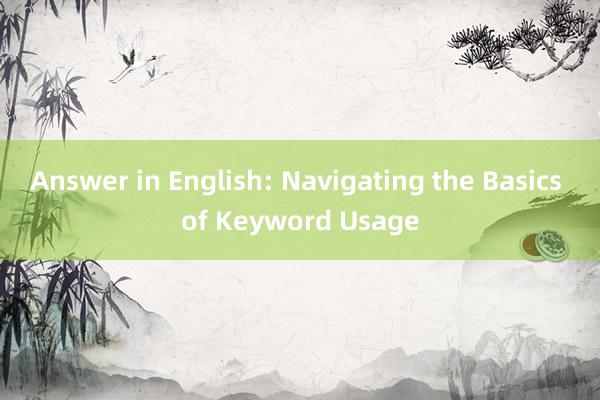时间:2024-09-14 06:20

Title: Answer in English: Navigating the Basics of Keyword Usage
Navigating the basics of keyword usage is crucial for anyone looking to enhance their online presence, whether it's through search engine optimization (SEO), content creation, or digital marketing strategies. Keywords play a pivotal role in guiding the flow of internet traffic towards your website, blog, or product page. This article aims to demystify the fundamental concepts surrounding keywords and provide insights into how to effectively use them.
广州敦雅装修用品有限公司### Understanding Keywords
Keywords are specific words or phrases that describe the content of a webpage or piece of content. They are the cornerstone of any SEO strategy, as they help search engines understand what your content is about and where to place it within search results. There are two main types of keywords: primary and secondary.
- **Primary Keywords**: These are the most important keywords related to your content. They should be included in the title, URL, header tags, and throughout the body text.
- **Secondary Keywords**: These support your primary keywords and help diversify your content's focus. They can be used in meta descriptions, alt tags,小熊猫生物-寻竹 and other on-page elements.
### Keyword Research
Effective keyword usage starts with thorough research. Tools like Google Keyword Planner, 江苏苏豪国际集团股份有限公司 SEMrush, Ahrefs, and Moz can provide valuable insights into what keywords are popular, how often they're searched,浙江绿洲装修用品有限公司 and their competition level. This step is crucial because it helps you identify keywords that not only attract relevant traffic but also align with your business goals.
### Incorporating Keywords Strategically
Once you've identified your keywords, it's time to incorporate them strategically into your content:
1. **Title Tag**: Include your primary keyword in the title tag, keeping it concise and compelling.
2. **Header Tags**: Use H1, H2, and H3 tags to structure your content, ensuring that your primary keyword appears in the H1 tag and secondary keywords in H2 and H3 tags.
3. **Meta Description**: Write a meta description that includes your primary keyword and encourages clicks by providing a clear summary of the content.
4. **Content Body**: Integrate your primary keyword naturally within the first 100 words of your content, followed by secondary keywords. Avoid keyword stuffing, which can negatively impact your SEO.
5. **Image Alt Text**: Use keywords in image alt text to improve visual content's discoverability.
6. **URL Structure**: Incorporate keywords into your URLs to make them SEO-friendly and easier for users to understand.
### Keyword Trends and Adaptation
Keyword trends are constantly evolving due to changes in consumer behavior, technological advancements, and algorithm updates. Regularly revisiting your keyword strategy and conducting new research will ensure that your content remains relevant and competitive.
### Conclusion
Navigating the basics of keyword usage involves understanding their importance, conducting thorough research, and integrating them strategically into your content. By following these guidelines浙江绿洲装修用品有限公司, you can optimize your online presence, attract more targeted traffic, and enhance your website's visibility in search engine results. Remember, the key to effective keyword usage lies in balance—using keywords appropriately without overdoing it to maintain both user satisfaction and search engine rankings.